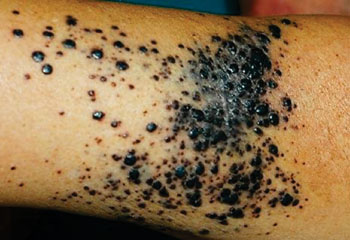Blood Test Monitors DNA Fragments for Melanoma Metastases
By LabMedica International staff writers
Posted on 25 Jan 2016
A blood test which monitors blood levels of DNA fragments from dead cancer cells does a superior job than the current standard test at tracking the severity and potential spread of metastatic melanoma.Posted on 25 Jan 2016
The standard test, in widespread use for decades to inform treatment decisions, measures blood levels of the enzyme lactate dehydrogenase (LDH). Levels of the enzyme tend to spike during aggressive tumor growth, but are also known to rise as part of other diseases and biological functions.

Image: Clinical features of local recurrences that are defined as the reappearance of melanoma in or contiguous with an excision scar or graft and bearing an in situ component (Photo courtesy of Dr. Paola Savoia).
Scientists at the New York University School of Medicine (NY, USA) and their colleagues looks at levels of circulating tumor DNA, or ctDNA, released into the blood when tumor cells die and break apart to spill their contents. They studied 31 patients with inoperable metastatic melanoma, which took three years to complete. All had one of the two most common genetic mutations linked to the frequently fatal skin cancer, B-Raf Proto-Oncogene, Serine/Threonine Kinase (BRAF) or Neuroblastoma RAS Viral (V-Ras) Oncogene Homolog (NRAS). All had ctDNA and LDH blood tests performed after therapy, and most before treatment.. Normal blood levels of ctDNA were statistically determined by averaging results from 30 people who did not have melanoma.
The ctDNA levels were determined using droplet digital PCR (ddPCR) assays. Among patients with samples available prior to treatment initiation ctDNA and LDH levels were elevated in 12/15 (80%) and 6/20 (30%) patients respectively. In patients with Response Evaluation Criteria In Solid Tumors (RECIST) scores greater than 5 cm prior to treatment initiation, ctDNA levels were elevated in 5/7 (71%) patients compared to LDH which was elevated in 1/13 (8%) patients. In addition, ctDNA levels were elevated in 13/16 (81%) instances of non-RECIST disease progression, including 10/12 (83%) instances of new brain metastases. In comparison LDH was elevated 8/16 (50%) instances of non-RECIST disease progression, including 6/12 (50%) instances of new brain metastases.
David Polsky, MD, PhD, the senior author of the study, said, “Our study results show that circulating tumor DNA is a superior blood test for evaluating and tracking progression of metastatic melanoma. A reliable blood test for tracking potential disease progression is preferred because blood tests offer feedback on what is happening throughout the body, while scans may not always visualize all parts of the body.” The study was published in the January, 2016 edition of the journal Molecular Oncology.
Related Links:
New York University School of Medicine













